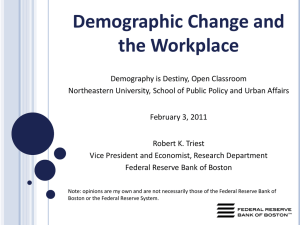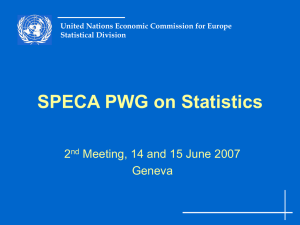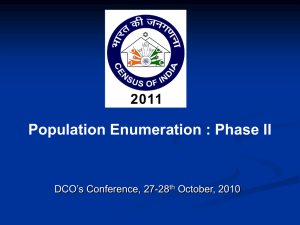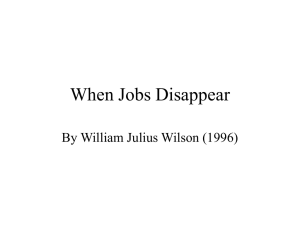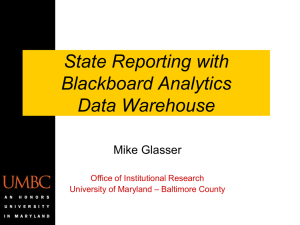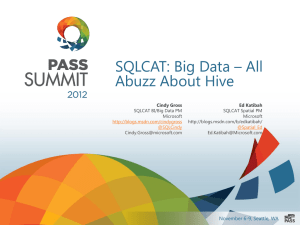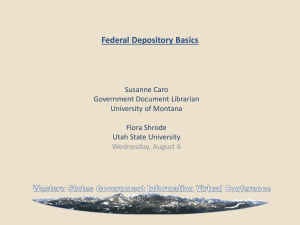Statistics on State and Local Governments
advertisement
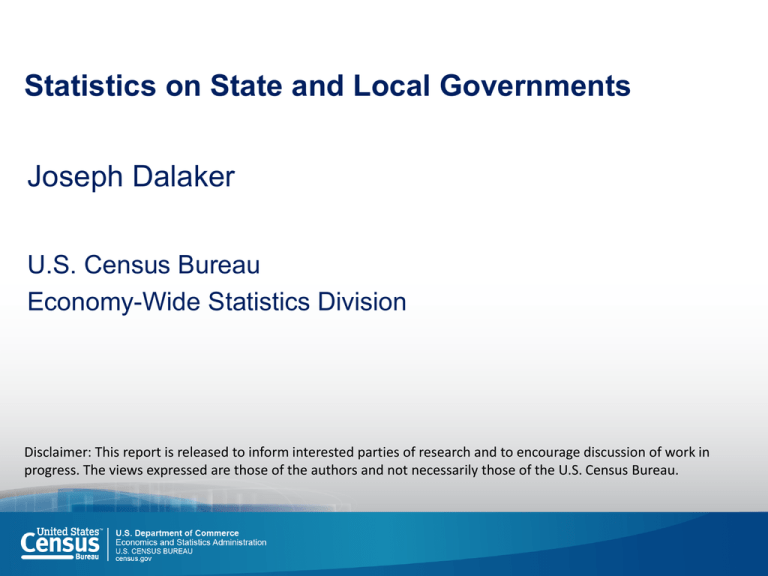
Statistics on State and Local Governments Joseph Dalaker U.S. Census Bureau Economy-Wide Statistics Division Disclaimer: This report is released to inform interested parties of research and to encourage discussion of work in progress. The views expressed are those of the authors and not necessarily those of the U.S. Census Bureau. Statistics About Governments Main purposes Provide economic statistics about governments Serve as public-sector counterpart to private sector Track activity of governments over time Response is voluntary Public nature of the data State and Local Government Data: Uses Calculation of important economic measures GDP: Bureau of Economic Analysis Flow of Funds: Federal Reserve Board Time series analysis Comparative analysis Public Policy Tax, health, education, welfare, transit, etc. Governments as Producers 80% 70% 60% 50% 40% Personal Consumption 68.5% 30% 20% 10% Private Domestic Investment 15.8% Net Exports -3.0% 0% -10% Components of Gross Domestic Product Source: Bureau of Economic Analysis, Table 1.1.5 Gross Domestic Product 2013 Government Expenditure 18.7% 7.3% Federal Govt. 11.4% State & Local Govt. Governments as Economic Entities Governments as employers: 16.5% of civilian labor force 2.1% federal government 14.4% state & local government 4.0% state government 10.4% local government (March 2012) Source: Bureau of Labor Statistics, 2012 Current Employment Statistics Survey and U.S. Census Bureau, 2012 Census of Governments: Public Employment and Payroll Government Statistics in the News 6 History of Statistics on Governments 1790 First Population Census 1850 Information collected in the Decennial Census included tax levies, governmental debt, and wealth, and the number and types of schools and their pupils 1840 Decennial Census collected some data on the number and types of schools and pupils 1902 First comprehensive compilation of governmental data by the new “Census Office” 1880 Inquiries included the number of schools, details about cities including sewage and drainage, utilities, and public services and 105 additional questions that assessed governments’ financial conditions 1957 First Census of Governments focusing on four major areas of data collection -Governmental Organization -Taxable Property Values -Employment -Finances 1950 Congress enacted legislation which provided that a “Census of Governments” be taken every 5 years, for years ending in “2” and “7” (Title 13, Section 161, U.S. Code) 2012 Census of Governments Census Bureau’s Statistics on Governments Statistics on Governments Frequency Survey/Program Data Available For: Data Items Included Sponsoring Agency Number of Units, Employment, Finance, etc. Census Bureau Functions performed, authorizing legislation, etc. Census Bureau Employment, wages, etc. Census Bureau Revenue, expenditures, etc. Census Bureau X Revenue, expenditures, etc. Census Bureau/NCES X X Contributions, assets, etc. Census Bureau X X X Revenue, expenditures, debt, assets Census Bureau Annual Survey of State Government Tax Collections X X Tax revenue Census Bureau Quarterly Survey of Public Pensions X Contributions, assets, etc. Census Bureau Quarterly Summary of State and Local Government Tax Revenues X Tax revenue Census Bureau US State County Census of Governments X X X Government Units Survey X Annual Survey of Public Employment and Payroll X X Annual Survey of State Government Finances X X Annual Survey of School System Finances X X Annual Survey of Public Pensions X Annual Survey of Local Government Finances Every 5 Years Annual Quarterly X X Census of Governments First conducted in 1957 Conducted every 5 years – ending 2 & 7 Content: Counts & structure of governments Employment measures Financial measures Census vs. Annual Surveys • Content is the same • Number of governments surveyed is different State and Local Government Data Collection Methods • • • • Mail canvass Electronic reporting - Centurion & Harvester Central collection - paper & electronic Compilations Content Government Organization Government Finances Public Employment and Payroll Government Organization Why is understanding government structure important? What is included and what isn’t? How are basic services provided? Which comparisons are valid? Defining a Government Three criteria for defining a government: Existence as an organized entity Governmental character Substantial autonomy Fiscal independence Administrative independence Governmental Structure Core government Executive, legislative, and sometimes judicial Dependent agencies Jointly governed activities Types of Governments 90,106 Government Organizations Measured and Defined 90,056 50 Local Governments State Governments 38,910 51, 146 General Purpose Governments Special Purpose Governments 3,031 19,519 16,360 38,266 Counties Cities Townships Special Districts Source: U.S. Census Bureau, 2012 Census of Governments 12,880 Independent School Districts Examples Government Airport authorities Cities Counties Sanitary districts States Non-Government Homeowners’ associations Most charter schools Many services can be provided either by governments or by private entities – what matters is how the entity is organized, whether it has governmental character, and whether it has substantial autonomy. Differences in Governmental Structure Among States State County Governments City Governments Township Governments Special District Governments School District Governments Alabama 67 461 0 548 132 Connecticut 0 30 149 447 17 Georgia 153 535 0 510 180 Indiana 91 569 1,006 752 291 New York 57 614 929 1,174 679 Texas 254 1,214 0 2,600 1,079 Washington 39 281 0 1,285 295 Source: U.S. Census Bureau, 2012 Census of Governments Number of Local Governments: United States The Evolving Picture of our Governments 1952 1982 2012 116,694 82,290 90,056 Counties 4% Counties 3% Total Number of Governments Source: 1952, 1982, & 2012 Census of Governments Counties 2% Government Finances Revenue by type Expenditure by character & function Debt by term Cash and securities by type of holding Data products by: topic (tax collections, public schools, pension systems) level of government (state, local, state and local combined) Finance Data are Nested State Tax State Finance Data Public Pension Data Public Education Data State and Local Finance Data Sources of Tax Revenue – Variety Among States Percent Distribution of State Government Tax Revenue Percent Distribution of State Government Tax Revenue Total % Sales Total General Sales Selective Sales License Income Taxes Total Taxes Total Individual Corporation All Other Income Income Taxes Total Property Taxes Other Taxes U.S. Average 100 46.4 30.1 16.3 6.6 41.9 36.6 5.3 5 .2 1.6 3.6 Alabama 100 50.8 25.2 25.6 5.3 38.7 34.6 4.1 5.2 3.5 1.7 Alaska 100 4.9 X 4.9 2.6 12.3 X 12.3 85.2 1.9 78.3 Delaware 100 14.6 X 14.6 37.6 43.0 33.8 9.3 4.8 X 4.8 Florida 100 82.5 60.1 22.4 5.8 6.0 X 6.0 5.8 >.01 5.8 Indiana 100 60.8 40.1 20.7 4.1 34.0 29.4 4.6 3.6 .04 3.6 Source: U.S. Census Bureau, 2013 Survey of State Government Tax Collections Government Employment Full-time employees Full-time gross payroll Part-time employees Part-time gross payroll Computed FTE State & Local Government Employment, U.S. Total and Alabama Percentage of Employees by Government Function 57.0 51.9 Education Public safety Social services & income maintenance General administration Environment & housing Other Transportation Utilities 11.1 9.6 11.1 18.8 6.5 5.7 4.9 4.9 3.8 3.2 3.0 3.8 2.6 2.1 U.S. Alabama SOURCE: 2012 Census of Governments: Employment www.census.gov/govs Reimbursable Programs Reimbursable Programs Frequency Every 5 Years Biennial Annual Biannual Survey/Program Data Available For: US State County Place Data Items Included Census of State and Federal Adult Correctional Facilities (Prison Census) X X Census of Jail Inmates X X Academic Libraries Survey X X Expenditures, staffing, circulation, etc. Census of Juveniles in Residential Placement Juvenile Residential Facility Survey Survey of Government Research and Development Expenditures Annual Survey of Jails Criminal Justice Expenditure and Employment Survey Annual Survey of School System Finances Federal Audit Clearinghouse Medical Expenditure Panel Survey - Public X X X X Demographic, offense, etc. Facility characteristics NCES (Dept. of Education) OJJDP (DOJ) OJJDP (DOJ) X X Type of R&D, funding, etc. NSF Jails and inmates BJS (DOJ) Finance and employment BJS (DOJ) Revenue, expenditures, etc. Finance Health plans, premiums, benefits, and enrollment National Public Education Financial Survey Census Bureau/NCES OMB AHRQ NCES (Dept. of Education) NCES (Dept. of Education) NCES (Dept. of Education) IMLS BJS (DOJ) X X X X X X Staffing, facility size, capacity, programs offered, basic prisoner information Staffing, facility size, capacity, programs offered, inmate characteristics Sponsoring Agency X X X X X X X X X X Revenue, expenditures X X Directory, membership, teachers, staff, dropouts, graduates X X Demographic and geographic support X X X X National Prisoner Statistics 8 X X Teacher Compensation Survey* X X Salaries, expenditures, degree earned, etc. National Prisoner Statistics 1B X X Characteristics of population School Attendance Boundary Survey X X Geographic school boundaries Common Core of Data Non-fiscal Education Demographic and Geographic Estimates Public Libraries Survey Survey of Sexual Violence X Circulation, visits, staffing, etc. Allegations, demographics Characteristics of persons under sentence of death and of execution BJS (DOJ) BJS (DOJ) BJS (DOJ) NCES (Dept. of Education) BJS (DOJ) NCES (Dept. of Education) Reimbursable Surveys Follow the survey life cycle Differences Contract negotiation Collection content determined by sponsor Deliverables content and date set by sponsor Follow sponsor’s statistical and publication standards Funding comes from sponsor Sponsoring agency releases the data Conclusion The Census Bureau collects information on state and local governments including their characteristics, finances, and employment. The Census Bureau also collects information for other agencies on topics including libraries, education, and criminal justice. Questions? Thank you! Joseph Dalaker Section Chief Data User Outreach and Education Branch Economy-Wide Statistics Division U.S. Census Bureau 1-800-242-2184 govs.cms.inquiry@census.gov
